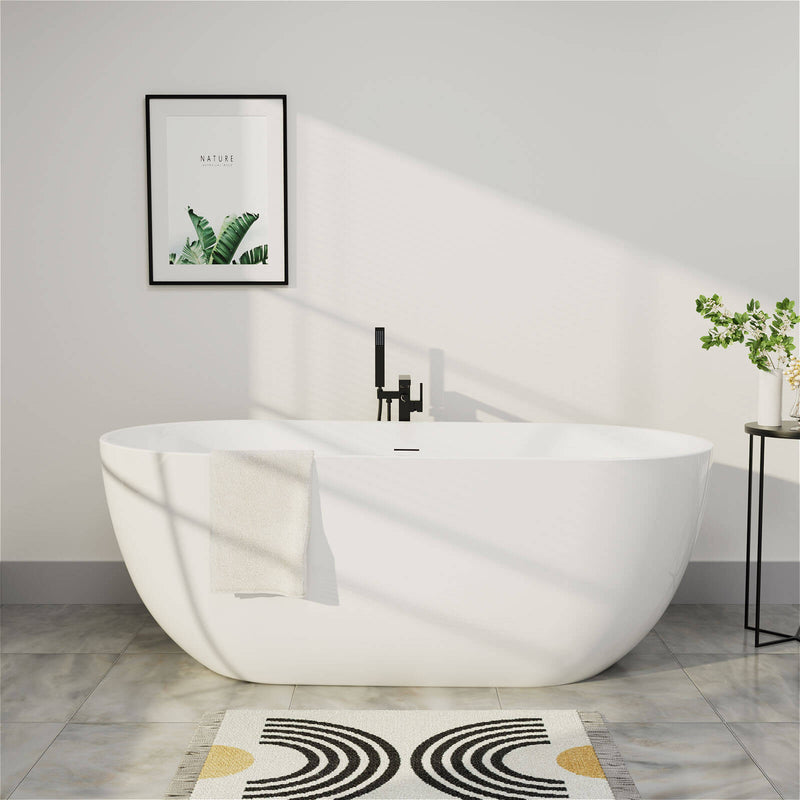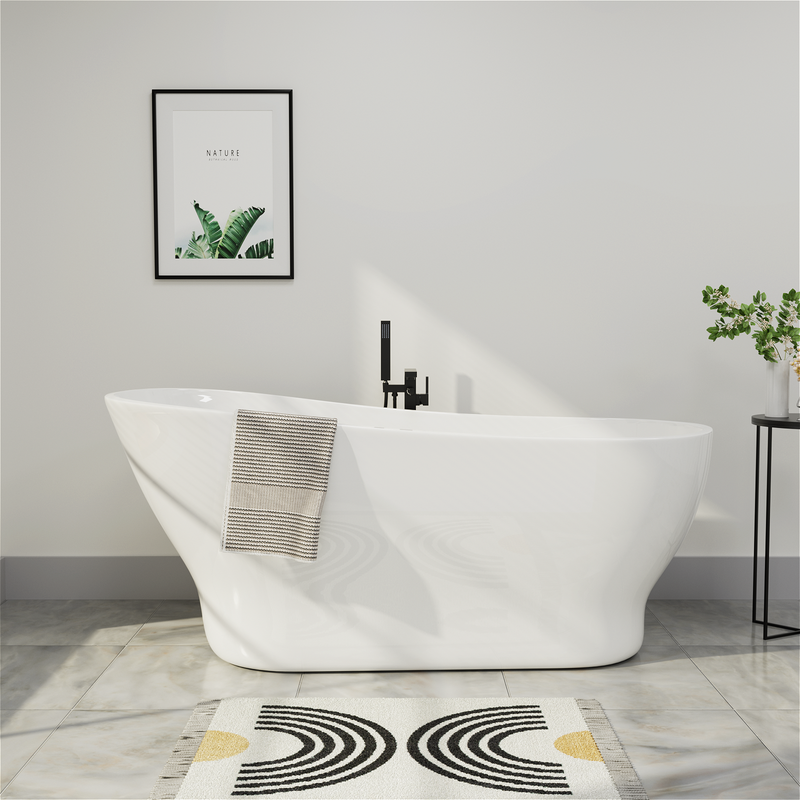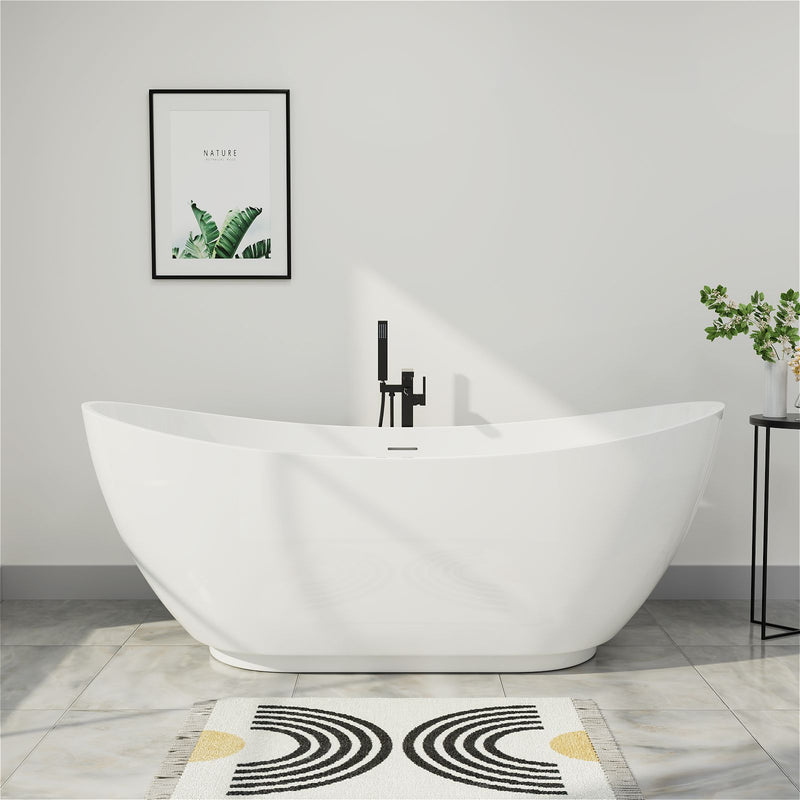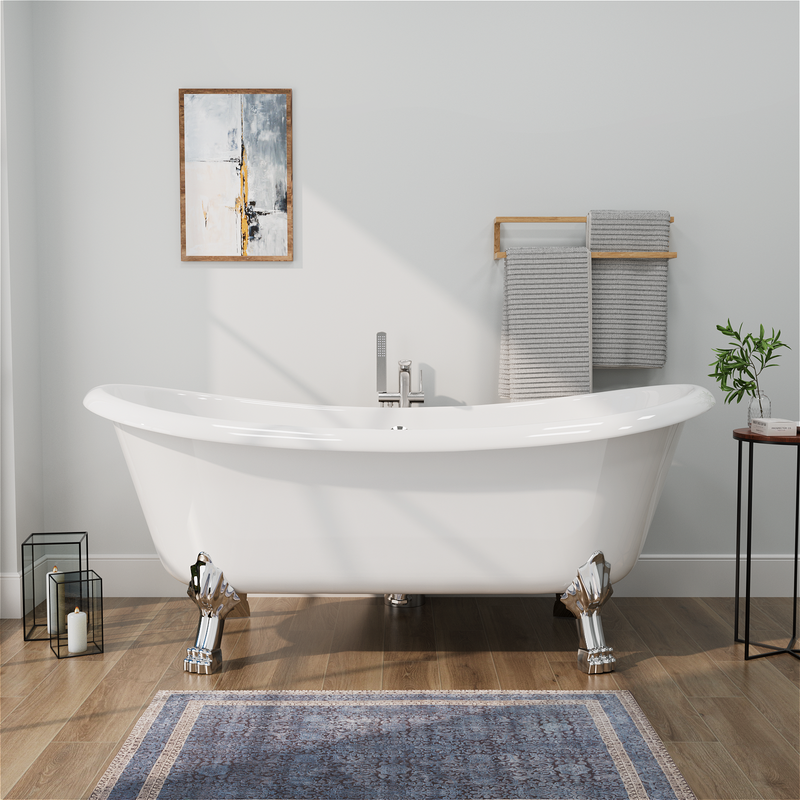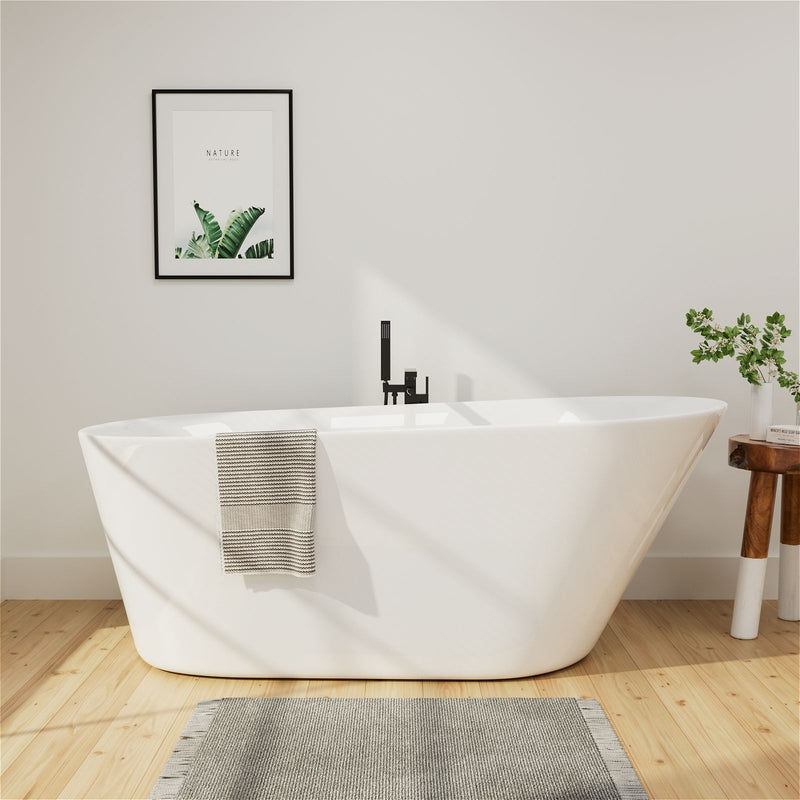Garden tubs are becoming increasingly popular and are large soaking tubs that elevate the average bathtub by offering a luxurious and relaxing experience. Unlike standard bathtubs, garden tubs are designed with comfort and style in mind and are often the finishing touch to a well-appointed bathroom. If you're considering adding a garden tub to your home or are just curious about what makes one special, this guide is for you.
What is a Garden Tub?
A garden tub is a soaking tub designed for ultimate relaxation. Larger and more luxurious than a standard bathtub, it allows you to soak your entire body, creating a spa-like experience at home. Garden tubs are typically oval in shape but are available in a variety of styles to suit a variety of bathroom styles.

The term "garden tub" comes from its historical use in outdoor gardens, where these deep soaking tubs were placed in gardens as a place for people to relax in nature. Over time, the concept was adapted for indoor bathrooms, retaining the same spacious, comfortable, and indulgent design.
These tubs are becoming increasingly popular because they offer a more luxurious bathing experience than the average bathtub. The large space allows you to enjoy a soak without having to worry about sticking your limbs out of the tub. Additionally, some materials are constructed to ensure superior heat retention, allowing for longer, more enjoyable bathing experiences.
History of Garden Tubs
The origins of garden tubs can be traced back to the early 18th century, when they became increasingly popular among the French elite and nobility. Significantly, these tubs were not just for bathing, they were also a luxurious viewing platform from which to admire the surrounding scenery.
Located in or above a garden, they earned their name from their unique design—the garden tub. Made primarily of zinc and adorned with elaborate decorations, these tubs symbolize luxury and sophistication.
Interestingly, the water drained after bathing was cleverly redirected back into the garden to nourish the plants—a combination of practicality and luxury. This innovative idea was not limited to France; the British soon took it home, incorporating garden tubs into their homes, strategically placing them near windows or in places with pleasant views to enhance the bathing experience.
Garden Tub Shapes
Garden tubs come in a variety of shapes, but they generally have one thing in common: an oval or round design. This modern design enhances the depth of the water, similar to a basin-style bathtub, allowing for full immersion when bathing. Additionally, these tubs are finished on all four sides like a standard freestanding tub, making them easy to use from all angles.
However, while this design allows for a deep soak, it may not be ideal for showering since the tub is set back from the wall. However, many garden tubs can be equipped with jets and pressurized water to provide a Jacuzzi-like spa experience.
Advantages of Garden Tub
Made with Quality Materials
Garden tubs can be customized to fit the style of your home. You can choose a stone resin tub or an enameled cast iron tub to enhance the rustic aesthetic, or a stainless steel tub to complement your country chic or industrial style.

Full Immersion for Comfort
Nothing beats the comfort of a fully submerged garden tub in a hot bath. Traditional bathtubs typically hold only waist-deep water or less. A garden tub is relaxing and can help you unwind and de-stress after a busy day. Add some bath salts for an even more therapeutic experience.
Accommodates Multiple People
Garden tubs are spacious enough to accommodate multiple people, yet private enough for a comfortable soak with your loved ones. If you have kids, a garden tub can also provide convenience and entertainment for all the little ones to soak together. However, keep in mind that garden tubs are deep and children will need to be supervised.
Timeless Elegance
A garden tub is an elegant addition to a bathroom that is both beautiful and relaxing. Add some decorations around the tub and stock it with bubble bath, candles, and bath salts for a luxurious experience.
Requires Less Cleaning
Garden tubs don’t usually require much cleaning unless you take a bath every night. Since they don’t have showers, they are usually only used occasionally for special occasions or after a busy day.
Disadvantages of Garden Tubs
May Require Professional Installation
Since most plumbing systems are designed with traditional corner tubs or showers in mind, installing a centrally located tub requires a lot of DIY labor or hiring a professional plumber. Additionally, manufacturers may use heavy materials to build a standard garden tub in one piece. Lifting a heavy tub to an upstairs bathroom can be a challenge. You’ll also want to make sure the installation area has structural framing support to withstand the weight of the tub once it’s filled with water.
Takes Up Floor Space
While one of the benefits of garden tubs is that they are spacious and deep, they also take up a lot of floor space. Many bathroom floor plans can’t accommodate the installation of a garden tub, and you may also need to consider the potential functionality of your bathroom layout. Even if a larger garden tub can fit in your bathroom, the design may not be appropriate for elderly people, children, or any family members with limited mobility.
More Expensive Than a Standard Tub
One of the biggest downsides to garden tubs is the price. They are much more expensive than regular bathtubs and are more expensive to repair. Additionally, if you want to replace a garden tub, it can be quite expensive to remove and reinstall. In addition to the cost of the garden tub itself, your water bills can also be higher if you soak in it frequently.
Materials can be Problematic
Depending on the type of garden tub you purchase, the materials it’s made of can cause issues. For example, some garden tubs are made of enameled cast iron and resin, which can retain heat, allowing you to enjoy a great soaking experience. Cast iron is also very durable, but it’s heavy and can cause stress or damage to your bathroom floor. Acrylic garden tubs are lighter and more affordable, but may not retain heat as well as cast iron or stone tubs.
Additional Water Heaters may be Needed
Garden tubs require a lot of water to fill. If your home or apartment building already consumes a lot of hot water, you may need to install a second water heater for your garden tub.
Things to Consider Before Installing a Garden Tub
Now that you've found the perfect tub, what's next? Installing a garden tub isn't always an easy DIY project, especially if the tub is large and heavy. Here are things you need to consider:

Plumbing and Drainage
Make sure your existing plumbing can support a garden tub, as they often require a different installation than a standard tub. Make sure the plumbing and drain are properly aligned to avoid leaks.
Weight and Support
Garden tubs are heavy, especially when full of water, so the floor needs to be strong enough to support it. You may need to reinforce the floor or consult a professional to make sure everything is secure.
Space and Dimensions
Measure your bathroom carefully to make sure the tub has enough room for plumbing and fixtures.
Permits and Regulations
Check local building codes to make sure your installation meets safety standards. You may need to apply for a permit for plumbing or structural modifications.
How to Care for a Garden Tub
Want to keep your garden tub looking sparkling and relaxing for years to come? Try these simple tips to keep it looking its best:
Daily Cleaning
Cleaning your tub regularly prevents dirt and soap scum from building up. Use non-abrasive cleaners like a soft cloth or sponge. Avoid harsh chemicals that can damage the tub's surface. Wiping down the tub after each use helps prevent water spots and stains.
Check for Leaks
Check your tub regularly for signs of leaks or water damage, especially around the faucets, drains, and tub base. Repair any leaks immediately to prevent water spots or mold growth.
Inspect and Maintain the Seal Around Your Garden Tub
The seal around your tub is essential to preventing leaks. Check it regularly for wear and tear. If you notice any damage, reseal it or replace it with a special adhesive for tub surrounds and shower walls to maintain the seal.
Treat Stains and Residue
For stubborn stains, make a paste of baking soda and water. Apply it to the stain, let it sit for a few minutes, and then gently scrub. Rinse the area thoroughly to remove any residue.
Regular Inspections
Check the overall condition of your tub regularly. Watch for cracks, chips, or damage. Fixing small issues early can help prevent bigger problems in the future.
With a little care, your garden tub can be the perfect place to relax for years to come. So take a bubble bath and enjoy!
FAQs About Garden Tubs
What exactly is a garden tub?
A garden tub is a large, deep, freestanding bathtub designed for comfortable soaking rather than quick showers. Characterized by its wide basin and ample depth, it's typically installed as a centerpiece in a master bathroom. The name comes from the concept of having enough space to arrange bath accessories and plants around the tub, creating a garden-like relaxing atmosphere.
How much space do I need for a garden tub?
Most garden tubs require a minimum of 60x42 inches of floor space, though larger models can extend to 72x48 inches or more. You'll also need to account for at least 24-30 inches of clearance around the tub for easy access and cleaning. Before installation, ensure your bathroom layout can accommodate these dimensions while maintaining comfortable traffic flow.
Are garden tubs practical for everyday use?
While garden tubs offer excellent relaxation benefits, they may not be the most practical choice for daily quick showers. Their large water capacity means longer filling times and higher water usage. Many homeowners find them perfect for weekend soaks or stress relief after long days, while maintaining a separate shower for daily hygiene routines.
What's the average cost range for a garden tub?
Basic acrylic garden tubs start around $800-$1,200, while mid-range models typically cost $1,500-$2,500. High-end materials like stone resin or copper can reach $3,000-$5,000. Remember to factor in installation costs, which can add $900-$2,000 depending on plumbing modifications and structural requirements.
Can I install a garden tub in an upstairs bathroom?
Upstairs installation is possible but requires careful consideration. A filled garden tub can weigh over 1,000 pounds, so structural assessment is crucial. Consult with a structural engineer to ensure your floor joists can support this weight. Lightweight acrylic or fiberglass models are better suited for upper-level installations than heavier materials like cast iron or stone.
How do I clean and maintain a garden tub?
Use non-abrasive cleaners and soft cloths to preserve the surface. For acrylic tubs, avoid harsh chemicals that can cause clouding. Stone resin tubs require pH-neutral cleaners to maintain their sealant. Regular maintenance should include checking for cracks, cleaning jets (if applicable), and ensuring proper drainage to prevent standing water issues.
What are the main disadvantages of garden tubs?
The primary concerns include high water consumption (often 80-100 gallons per fill), substantial space requirements, and potential accessibility issues due to their depth. They may also be challenging to enter and exit for individuals with mobility concerns, and their large surface area requires more frequent cleaning.
Do garden tubs increase home value?
Garden tubs can increase home value when they align with neighborhood standards and buyer expectations. They're most valuable in master suites of mid-to high-range homes. However, in markets where buyers prioritize space efficiency, a large garden tub might be seen as impractical. Consider your local real estate market before investing.
What's the difference between a garden tub and a soaking tub?
While both are designed for immersion bathing, garden tubs are typically wider and shallower, focusing on spacious comfort. Soaking tubs are generally deeper and narrower, prioritizing full-body submersion in a more compact footprint. Garden tubs emphasize luxury and relaxation space, while soaking tubs focus on efficient deep-water immersion.
Can I add jets to a garden tub?
Many garden tub models offer optional jet systems for hydrotherapy benefits. However, adding jets to a non-jetted tub after installation is usually not feasible. If you want hydrotherapy features, choose a model specifically designed with jets from the beginning. Keep in mind that jetted systems require additional maintenance and cleaning.

